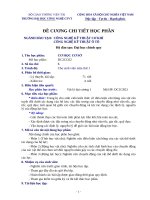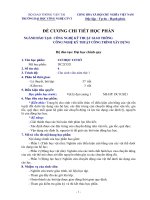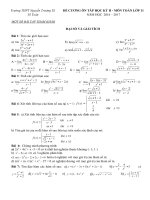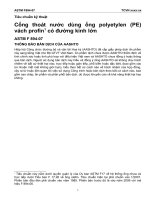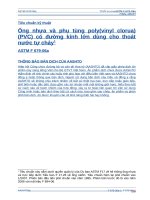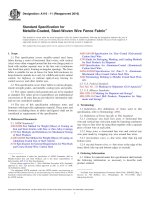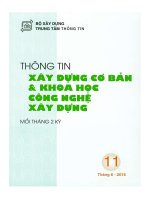Astm f 2832 11 (2016)
Bạn đang xem bản rút gọn của tài liệu. Xem và tải ngay bản đầy đủ của tài liệu tại đây (142.73 KB, 5 trang )
Designation: F2832 − 11 (Reapproved 2016)
Standard Guide for
Accelerated Corrosion Testing for Mechanical Fasteners1
This standard is issued under the fixed designation F2832; the number immediately following the designation indicates the year of
original adoption or, in the case of revision, the year of last revision. A number in parentheses indicates the year of last reapproval. A
superscript epsilon (´) indicates an editorial change since the last revision or reapproval.
F1470 Practice for Fastener Sampling for Specified Mechanical Properties and Performance Inspection
F1789 Terminology for F16 Mechanical Fasteners
G1 Practice for Preparing, Cleaning, and Evaluating Corrosion Test Specimens
2.2 ASME Standard:3
ASME B18.12 – Glossary of Terms for Mechanical Fasteners
2.3 IFI Standards4
IFI-170 –Accelerated Corrosion Test for Mechanical Fasteners
1. Scope
1.1 This guide covers test procedures for performing accelerated tests to evaluate relative corrosion resistance of various
coatings applied to mechanical fasteners. Corrosion mechanisms such as general and crevice corrosion may be evaluated
with this method. Test duration may be selected to achieve any
desired level of corrosion exposure and provides a frame of
reference to determine relative coating resistance to corrosion.
Fasteners tightened to a desired tension and subjected to this
test procedure may be evaluated to simulate a variety of service
conditions. Without large amounts of accumulated field results,
it is difficult to relate test duration or the number of test cycles
to actual service life for a given application.
3. Terminology
1.2 This standard is not intended to cover tests of driven
fasteners such as nails, staples, screws and lag bolts.
3.1 Definitions for many of the terms used in this standard
are included in Terminology F1789 and ASME B18.12.
1.3 Units—The values stated in SI units are to be regarded
as standard. No other units of measurement are included in this
standard.
1.4 This standard does not purport to address all of the
safety concerns, if any, associated with its use. It is the
responsibility of the user of this standard to establish appropriate safety and health practices and determine the applicability of regulatory limitations prior to use.
3.2 Definitions of Terms Specific to This Standard:
3.2.1 cycle—a series of events scheduled over a 24-hour
period
3.2.2 phase—a test period which has elapsed for 8 cycles.
3.2.3 test duration—a series of cycles as defined in
Section 4.
4. Test Duration
4.1 Test duration is specified as A, B, C, D or E in
accordance with Table 1.
2. Referenced Documents
2.1 ASTM Standards:2
A480/A480M Specification for General Requirements for
Flat-Rolled Stainless and Heat-Resisting Steel Plate,
Sheet, and Strip
B117 Practice for Operating Salt Spray (Fog) Apparatus
B605 Specification for Electrodeposited Coatings of TinNickel Alloy
D1193 Specification for Reagent Water
4.2 A typical cycle is shown in Table 2.
5. Apparatus and Materials
5.1 Coupons 25.4 mm wide and 50.8 mm long having a
thickness selected from Table 3 shall be used. Dimensional
tolerances of Specification A480/A480M shall apply. Coupons
shall have a plain finish and be manufactured from AISI–1008
steel grade. Coupons shall be included with fasteners to be
tested to verify that uniform amounts of corrosion have been
produced by tests. Refer to Fig. 1, Fig. 1 (a) and Fig. 1(b) and
Table 3. Inclusion of a metal loss coupon assists in making
1
This guide is under the jurisdiction of ASTM Committee F16 on Fasteners and
is the direct responsibility of Subcommittee F16.01 on Test Methods.
Current edition approved Sept. 1, 2016. Published September 2016. Originally
approved in 2011. Last previous edition approved in 2011 as F2832– 11. DOI:
10.1520/F2832–11
2
For referenced ASTM standards, visit the ASTM website, www.astm.org, or
contact ASTM Customer Service at For Annual Book of ASTM
Standards volume information, refer to the standard’s Document Summary page on
the ASTM website.
3
Available from American Society of Mechanical Engineers (ASME), ASME
International Headquarters, Two Park Ave., New York, NY 10016-5990, http://
www.asme.org.
4
Available from Industrial Fasteners Institute (IFI), 6363 Oak Tree Blvd.
Independence, OH 44131 .
Copyright © ASTM International, 100 Barr Harbor Drive, PO Box C700, West Conshohocken, PA 19428-2959. United States
1
F2832 − 11 (2016)
TABLE 1 Test Duration
Test Duration
A
B
C
D
E (# of cycles)A
7.3 Coupons to be tested shall be permanently identified by
numbers stamped onto the surface.
Number of Cycles
8
16
40
80
>80
7.4 Coupons to be used shall be cleaned with a methanol or
acetone solution and weighed prior to use. A coupon’s weight
in 6 0.5-mg shall be recorded for comparison with its weight
after testing in accordance with Table 2.
A
For special applications as agreed between supplier and purchaser.
7.5 Coupons as shown in Fig. 1(a) shall be installed by
drilling a hole to accept a nonmetallic hex fastener. Coupons
shall be raised above coupon racks by two nonmetallic washers
to expose both sides of coupons to the test environment. A
minimum of 5 mm shall be provided for spacing between
coupons and test rack surfaces. Fixtures shall be modified as
necessary to maintain isolation from rack materials while
creating and maintaining the required fastener tensions.
comparisons from one test to another and allows one to
quantify a repeatable test.
5.2 A fog humidity cabinet shall be used in which salt mist
applications are coupled with high humidity and moderately
high temperature. Water fog or visible water droplets on parts
being tested shall be continuous after equilibrium is reached.
Dry-off may be sequenced manually or automatically.
7.6 Dry off shall consist of exposure to high temperature,
low humidity air in accordance with Table 4 for three hours.
5.3 Racks suitable for supporting bolt or screw assemblies
shall be agreed upon between supplier and purchaser. Test
results shall always state materials used for racks during
testing. Nylon or other suitable nonmetallic washers shall be
installed to prevent bolt or screw heads or test coupons from
contact with test racks. See Fig. 1 and 7.8.
7.7 Test coupon(s) shall be removed and analyzed after
dry-off in each phase. Each coupon shall be cleaned in
accordance with the procedures described in Practice G1.
7.8 For corrosion products that are tightly adhered to the
fastener specimen, cleaning by mechanically abrading the
surface before chemical cleaning will help remove the adherent
corrosion products. Vigorous mechanical cleaning may result
in the removal of some coating or base metal; therefore, care
should be exercised when using mechanical cleaning techniques. Mechanical cleaning should be used only when other
methods have failed to provide adequate removal of corrosion
products on the coupons. After a final phase, coupon mass loss
shall be evaluated based on Table 3. Prior to completion of a
final testing phase, mass loss may be linearly extrapolated
based on percent of the overall test completed.
6. Salt Mist Application and Dry-off
6.1 Salt solution shall conform to requirements of Table 4.
Solutions shall be sprayed by nozzles to provide a mist such
that test fasteners and coupons are thoroughly wet and dripping
when examined visually. Solution collection rates shall conform to Practice B117. Salt accumulations shall have been
rinsed away during the salt solution spray application.
6.2 For the drying part of a cycle, a dry-off environment
area shall be maintained with sufficient air circulation to assure
uniform temperature and shall allow thorough drying of tested
fasteners and coupons. Temperature and humidity conditions
are defined in Table 4.
8. Report
8.1 Reported test results shall include:
8.1.1 Name of testing agency,
8.1.2 Date(s) and place of testing,
8.1.3 Testing schedule as to number of cycles,
8.1.4 Identification, all materials for coupons,
8.1.5 Materials of construction for racks,
8.1.6 Identification, materials and coatings of fasteners,
8.1.7 Installation torques or tensions involved,
8.1.8 Condition of coupons,
8.1.9 Mass loss of coupons, net and percent, and
8.1.10 Condition of the fasteners, including section loss,
estimated percent surface corrosion, timing of on-set, or
photographs as agreed with purchaser.
7. Test Procedure
7.1 Fasteners to be tested with salt spray, shall be sampled
in accordance with Practice F1470, Sample Level B.
7.2 Each fastener to be tested shall be installed through its
corresponding rack using nonmetallic washers as to maintain a
minimum of 5 mm spacing between underside of the head and
surface of the rack. The washers for any testing protocol shall
be identical. Fig. 1(a) and Fig. 1(b) provide an illustrative
representation. Holes in test racks shall be offset to avoid
dripping from one test fastener onto another. Fastener load
shall be achieved through finger tightening (Fig. 1 illustrates
the assembly). If higher loads or proof load tightening is
required then the load level and method of tightening shall be
by agreement between supplier and purchaser.
9. Keywords
9.1 corrosion; crevice; testing
2
F2832 − 11 (2016)
TABLE 2 Typical Schedule
Time
A
6 a.m.
2:00 p.m.
10:00 p.m.
Weekends
Duration
Hrs
8
8
8
Event
Salt mist application (in ambient environment.)
8 hour humidity cabinet exposure including 1 hour progression to wet conditions.
8 hour environmental exposure including 3 hours progression to dry conditions.
Ambient environment
A
Times shown are illustrative. A test cycle may be started at any time and follow the order shown in the table. The events for a 24 h period complete one cycle. Ambient
is specified in Table 4. Duration times are ± 5 minutes.
TABLE 3 Coupon Mass Loss Target Range
Initial
Coupon
Thickness
mm
0.79
1.59
Test Duration
mg of Mass Loss
A
B
C
D
E
828–1228
874–1274
1496–1896
1574–1974
3210–3810
3378–3978
6038–6638
6345–6945
SeeA
A
The corrosion rate (mass loss) is in linear relation with the number of test cycles. This linear relation can be used to calculate the mass loss for the number of cycles
different than the test cycles corresponding to test durations shown in Table 3. Values in Table 3 are only applicable to Standard Test Procedure. Mass loss for test duration
E(# of Cycles) is a function of the number of the cycles agreed upon.
3
F2832 − 11 (2016)
FIG. 1 Coupon and Fastener Illustrations
TABLE 4 Test Environment and Solutions
Salt Mist
Salt Solution
Sodium Chloride
Calcium Chloride
Sodium Bicarbonate
Salt Solution pH
Dry off
Temperature
Humidity
Ambient
Temperature
Humidity
25°C—35°C
0.90%A
0.10%
0.25%A
6.5–7.5
58°C-64°C
<30% RH
23°C-27°C
40–50% RH
A
Material must be dissolved separately in water (Specification D1193 type IV) and
added to the solution of other materials to avoid insoluble precipitates
4
F2832 − 11 (2016)
APPENDIX
(Nonmandatory Information)
X1. Testing Results
X1.1 Testing results from this specification cannot guarantee actual material performance. The relationship between test
duration and service condition should be agreed upon by the
test requestor and testing agency. Five test durations: A, B, C,
D, and E(# of Cycles) are intended to estimate approximate
years of service: Five service conditions are simulated in
testing. They are:
A) mild service— year,
B) moderate service—2 years,
C) severe service—5 years,
D) very severe service—10 years,
E) extended life service > 10 years (See Note X1.1).
Very severe, severe, moderate, and mild service are defined in
ASTM B605. Test duration selection A, B, C, D or E(# of
Cycles) should be based on the expected service condition. A
weight loss exceeding 2% is considered very severe service.
NOTE X1.1—Extended life service reflects special service applications
where design life exceeds a 10-year period and testing exceeds 80 cycles.
ASTM International takes no position respecting the validity of any patent rights asserted in connection with any item mentioned
in this standard. Users of this standard are expressly advised that determination of the validity of any such patent rights, and the risk
of infringement of such rights, are entirely their own responsibility.
This standard is subject to revision at any time by the responsible technical committee and must be reviewed every five years and
if not revised, either reapproved or withdrawn. Your comments are invited either for revision of this standard or for additional standards
and should be addressed to ASTM International Headquarters. Your comments will receive careful consideration at a meeting of the
responsible technical committee, which you may attend. If you feel that your comments have not received a fair hearing you should
make your views known to the ASTM Committee on Standards, at the address shown below.
This standard is copyrighted by ASTM International, 100 Barr Harbor Drive, PO Box C700, West Conshohocken, PA 19428-2959,
United States. Individual reprints (single or multiple copies) of this standard may be obtained by contacting ASTM at the above
address or at 610-832-9585 (phone), 610-832-9555 (fax), or (e-mail); or through the ASTM website
(www.astm.org). Permission rights to photocopy the standard may also be secured from the Copyright Clearance Center, 222
Rosewood Drive, Danvers, MA 01923, Tel: (978) 646-2600; />
5
